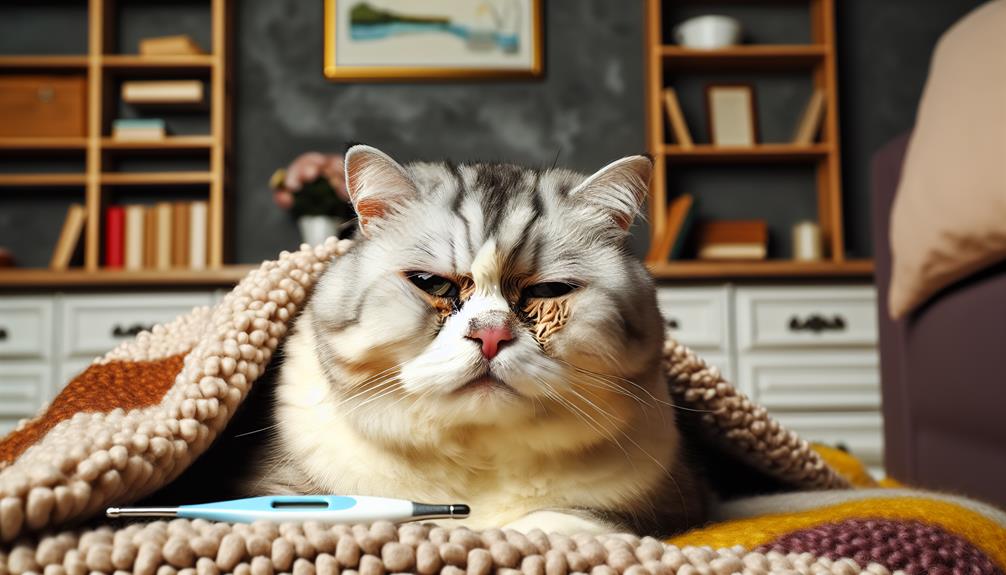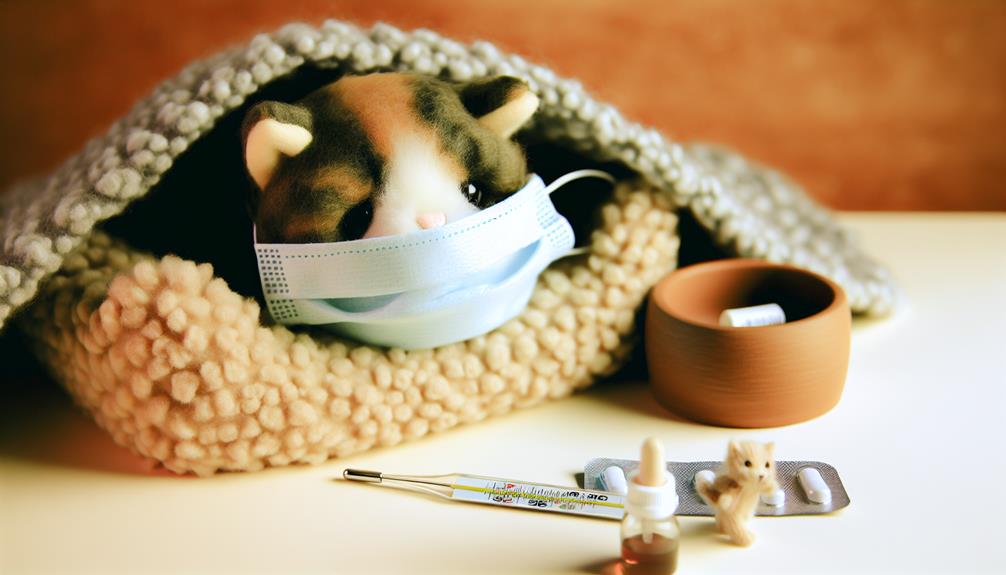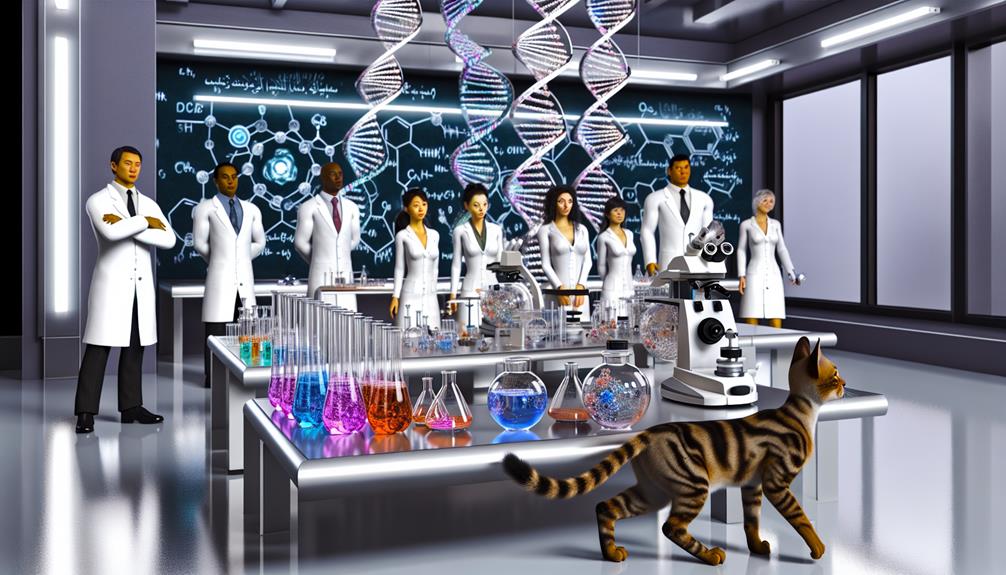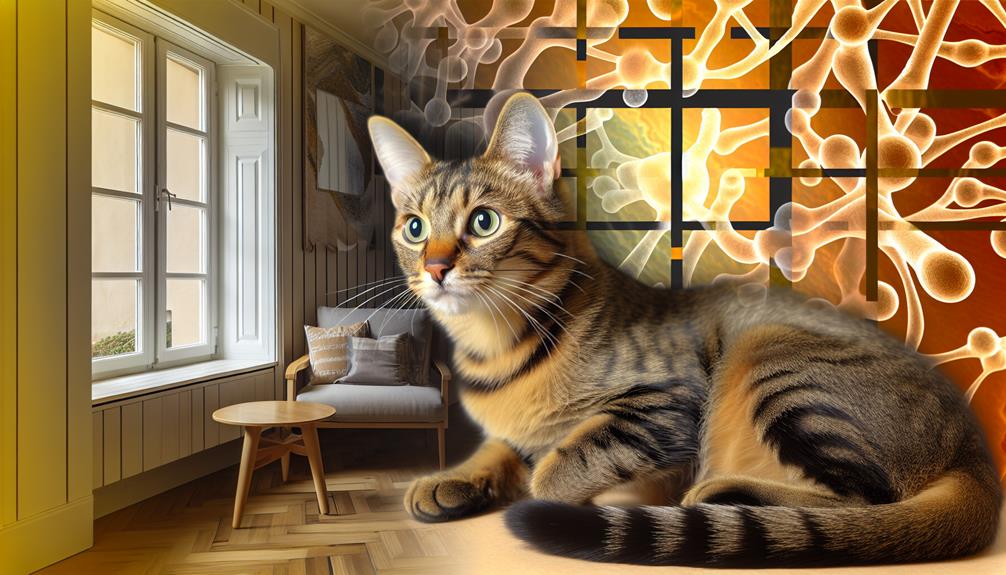You might be wondering if your feline friend can catch COVID-19, and the answer is yes, they can. Cats are susceptible to the virus, primarily through close contact with infected humans or other animals. While most cats exhibit mild symptoms, including respiratory issues and occasionally gastrointestinal problems, it's essential to stay vigilant. How exactly can you protect your pet and what should you look out for? There are specific steps and signs every cat owner needs to be aware of to guarantee their pet's health during these uncertain times.
Understanding COVID-19 in Cats
Understanding COVID-19 in cats involves examining the transmission dynamics, symptomatology, and potential risks posed by the virus. To begin with, it's important to recognize how the virus affects cat behavior and overall feline health. Studies indicate that cats can contract SARS-CoV-2, the virus responsible for COVID-19, primarily through close contact with infected humans or other animals. Although cases are relatively rare, they do underscore the need for vigilance.
Symptomatically, infected cats can exhibit respiratory symptoms such as coughing, sneezing, and nasal discharge. Some may display gastrointestinal signs like vomiting and diarrhea. Additionally, lethargy and reduced appetite are common. It's essential to observe changes in cat behavior as early indicators of illness. Rapid intervention can mitigate severe outcomes, ensuring better feline health.
In terms of transmission dynamics, research suggests that while cats can contract and potentially transmit the virus to other cats, such instances are infrequent. The virus binds to the ACE2 receptors in feline cells, similar to its mechanism in humans. However, the replication efficiency in cats appears lower, reducing widespread outbreaks among felines.
Potential risks include the exacerbation of pre-existing health conditions. Cats with compromised immune systems or chronic illnesses might be more susceptible to severe symptoms. Consequently, regular veterinary check-ups are essential to monitor feline health, especially during the pandemic.
Understanding these factors helps you make informed decisions about your pet's well-being. By staying informed about how COVID-19 impacts cats, you're better equipped to protect your feline companion, ensuring they remain healthy and happy amidst ongoing uncertainties.
Transmission Between Cats and Humans
While the interaction between cats and humans is often a source of joy, it is important to recognize the potential for SARS-CoV-2 transmission in these close-knit relationships. Understanding how the virus can move between species is significant for mitigating human exposure and ensuring the well-being of both you and your feline companions.
Several factors contribute to the potential for transmission between cats and humans:
- Feline Carriers: Cats can become carriers of the virus after exposure to infected humans or other animals. Although cases of cats transmitting SARS-CoV-2 to humans are rare, the possibility exists, particularly if the cat exhibits asymptomatic cases.
- Environmental Factors: The virus's stability on surfaces and in aerosols can influence transmission pathways. Shared living environments increase the likelihood of cross species transmission, especially in households where physical distancing measures are less feasible.
- Virus Mutations: Continuous virus mutations can potentially alter transmission dynamics. Understanding these mutations is critical for evaluating the risk of zoonotic diseases and their spread between humans and animals.
Research indicates that while cats can contract and potentially transmit SARS-CoV-2, the primary route of infection remains human-to-human. However, you should still exercise caution to minimize risks. Key preventive measures include:
- Limiting close contact with your cat if you're infected
- Practicing good hygiene, such as frequent handwashing
- Keeping your cat indoors to reduce exposure to other animals
Symptoms of COVID-19 in Cats

When a cat contracts COVID-19, it may exhibit symptoms that are similar to those observed in humans, though typically milder. You might notice respiratory signs such as coughing, sneezing, and nasal discharge. Additionally, some cats may develop gastrointestinal symptoms like diarrhea and vomiting. These manifestations are a result of the virus infiltrating the respiratory and gastrointestinal tracts, leading to inflammation and symptomatic responses.
Changes in feline behavior can also serve as indicators of illness. A cat that was once active might become lethargic, show a decreased appetite, or exhibit signs of depression. Behavioral changes such as increased hiding, reluctance to engage in play, or altered grooming patterns can also be symptomatic of COVID-19. It's important to monitor these alterations closely, as they might indicate underlying health concerns that necessitate veterinary attention.
The virus responsible for COVID-19, SARS-CoV-2, can undergo mutations, potentially altering its ability to infect different species, including felines. While the virus mutation might not notably change the clinical symptoms in cats, it's essential to stay informed about emerging variants and their potential impacts. Evidence suggests that, although rare, severe cases can occur, leading to pneumonia and other complications that could be life-threatening.
Diagnosing COVID-19 in Cats
When diagnosing COVID-19 in cats, you'll need to be aware of the symptoms that mimic those in humans, such as respiratory distress and lethargy. Testing involves specific veterinary procedures, including nasal and oral swabs, to detect the presence of the virus. Consulting your veterinarian is essential, as they can accurately interpret test results and recommend appropriate treatment.
Symptoms in Felines
Identifying the symptoms of COVID-19 in cats is vital for ensuring timely and effective veterinary care. Unlike humans, felines may exhibit a range of signs that are less obvious and can often be confused with other respiratory or gastrointestinal conditions. Monitoring your cat's health closely can help you detect any deviations in their normal feline behavior, which might indicate an underlying issue such as a viral infection.
Here's what to look for:
- Respiratory symptoms: These can include coughing, sneezing, nasal discharge, and difficulty breathing. These symptoms result from the body's immune response to the virus.
- Gastrointestinal issues: Vomiting, diarrhea, or a sudden loss of appetite can signal that your cat's system is fighting off an infection.
- Lethargy and fever: A drop in energy levels, coupled with an unusual rise in body temperature, might be a sign that your cat is unwell.
It's important to observe any changes in your cat's typical behavior and consult a veterinarian if you notice these symptoms. Early detection and professional guidance can greatly enhance your feline's chances for a swift recovery. Keep in mind that while these symptoms can be indicative of COVID-19, they are not conclusive without professional testing.
Testing Procedures Explained
As veterinary science advances, understanding the testing procedures for diagnosing COVID-19 in cats becomes vital for pet owners and veterinarians alike. Determining whether your feline companion has contracted SARS-CoV-2 involves several specific testing methods designed to detect the presence of the virus or the animal's immune response to it.
The primary testing method for diagnosing COVID-19 in cats is the reverse transcription polymerase chain reaction (RT-PCR) test. This method detects viral RNA from swab samples taken from the cat's nose, throat, or rectum. RT-PCR is highly sensitive and specific, making it the gold standard in feline testing. Another approach involves serological tests, which identify antibodies in the cat's blood, indicating prior exposure to the virus. These tests are particularly useful for understanding the spread and immune response within the feline population.
When conducting these tests, it's essential to follow strict biosecurity measures to prevent cross-contamination and guarantee accurate results. Samples must be handled and processed in laboratories equipped for high-level biosafety. Through these evidence-based testing methods, veterinarians can confirm if a cat has been infected and proceed with the appropriate care measures.
Veterinary Consultation Importance
Understanding the testing procedures is just the beginning; seeking veterinary consultation plays a pivotal role in diagnosing COVID-19 in cats effectively. Engaging a veterinarian guarantees that your feline friend receives accurate diagnostic assessments and tailored care plans. Here's why veterinary guidance is essential:
- Expertise in Diagnostics: Veterinarians possess specialized training to interpret test results and clinical signs accurately. Their expertise helps differentiate COVID-19 from other feline respiratory illnesses.
- Comprehensive Care Plans: Beyond diagnosis, veterinarians offer holistic care strategies, addressing both immediate symptoms and long-term health maintenance.
- Telehealth Consultations: In situations where in-person visits are challenging, telehealth consultations provide an accessible means to obtain professional advice and monitor your cat's condition remotely.
Veterinary guidance guarantees that you're not maneuvering through the complexities of feline COVID-19 alone. Professional input can prevent misdiagnoses and inappropriate treatments, which might exacerbate your cat's condition. Telehealth consultations have become indispensable, especially during times of heightened health concerns, allowing for continuous veterinary support. Remember, timely and expert veterinary consultation is paramount for the effective management of COVID-19 in cats, safeguarding their well-being and your peace of mind.
Treatment and Care for Infected Cats

When your cat tests positive for COVID-19, prompt and appropriate treatment and care are vital to assure their well-being. First, initiate home care by setting up a comfortable isolation area where your cat can rest without risking transmission to other pets or people. Isolation protocols are essential for preventing further spread of the virus.
Monitor your cat's symptoms regularly, including their respiratory rate, appetite, and behavior. Veterinary resources are invaluable here; consult your vet for specific guidance tailored to your cat's condition. Nutritional support plays a considerable role in recovery. Make sure your cat receives a balanced diet rich in essential nutrients, which can bolster their immune system and expedite recovery.
Stress management is another key component. Cats are highly sensitive to changes in their environment, so maintaining a calm, quiet space can help reduce stress and promote healing. Emotional well-being shouldn't be overlooked either; spend quality time with your cat while observing social distancing measures, as your presence can provide comfort.
Environmental adjustments might also be necessary. Make sure the isolation area is well-ventilated and sanitized regularly to minimize viral load. Clean food and water dishes frequently, and wash your hands before and after handling your cat.
Lastly, keep in close contact with your veterinarian throughout the recovery process. They can offer advice on potential treatments, such as antiviral medications, and help you navigate any complications that arise. By adhering to these guidelines, you can greatly improve your cat's chances of a swift and complete recovery.
Preventing COVID-19 in Cats
To minimize the risk of COVID-19 transmission to your cat, it is crucial to limit their interactions with individuals outside your household. Implementing regular hygiene practices, such as washing your hands before and after handling your pet, can further reduce potential exposure. Evidence suggests these measures are effective in preventing the spread of the virus to feline companions.
Limiting Cat Interactions
During the ongoing COVID-19 pandemic, it's vital to limit your cat's interactions with people and other animals outside your household to mitigate the risk of transmission. Scientific research indicates that cats can contract SARS-CoV-2, the virus responsible for COVID-19, from humans and potentially spread it to other animals. Consequently, practicing social distancing isn't just for humans; it's essential for pets too.
To effectively reduce the risk, adhere to these interaction guidelines:
- Keep Cats Indoors: By keeping your cat indoors, you can considerably minimize their exposure to potentially infected individuals or animals.
- Limit Contact with Strangers: If someone outside your household needs to interact with your cat, make sure they follow strict hygiene protocols, including wearing masks and washing hands thoroughly before and after contact.
- Avoid Pet Gatherings: Refrain from taking your cat to places where they might encounter other pets, such as parks or pet-friendly events, to prevent cross-species transmission.
Implementing these strategies can help maintain the health and safety of your feline friends. It's a collective effort to follow these evidence-based guidelines, making certain both human and animal populations remain protected during the pandemic.
Regular Hygiene Practices
Maintaining regular hygiene practices is vital for preventing COVID-19 in cats, especially given the zoonotic nature of the virus. Keeping a clean environment through well-established cleaning routines can greatly reduce the risk of viral transmission. Utilize appropriate hygiene products designed for pet use to disinfect surfaces and objects that your cat frequently contacts.
| Emotion | Actionable Step |
|---|---|
| Concerned | Regularly clean litter boxes |
| Protective | Sanitize feeding bowls daily |
| Responsible | Wash your hands before and after handling |
| Caring | Use pet-safe disinfectants on surfaces |
Research indicates that SARS-CoV-2, the virus responsible for COVID-19, can survive on surfaces for varying durations. As a result, it's essential to incorporate thorough cleaning routines. Make sure litter boxes are cleaned and disinfected regularly, and feeding bowls are sanitized daily. Washing your hands before and after handling your cat reduces the risk of transferring pathogens.
Using pet-safe hygiene products is paramount. Harsh chemicals can be harmful to cats, so opt for disinfectants specifically formulated for pet environments. Regularly disinfect surfaces like cat beds, toys, and other frequently touched items to maintain a hygienic setting. Implementing these practices helps safeguard not just your cat, but your entire household, from potential viral exposure.
Research and Future Insights

Emerging research into the transmission of COVID-19 among domestic cats has revealed intriguing, albeit preliminary, findings. Scientists have identified that cats can indeed contract SARS-CoV-2, the virus responsible for COVID-19. While the severity of symptoms in felines varies, these developments have significant implications for pet owners and the broader scientific community. Here are three key points derived from recent studies:
- Transmission Dynamics: Studies have shown that cats can transmit the virus to other cats through respiratory droplets. This raises questions about the potential role of pets in the broader epidemiology of COVID-19.
- Symptomatology and Severity: Infected cats typically exhibit mild respiratory issues, but more severe cases have been documented. This variability underscores the need for more extensive research on feline health and COVID-19.
- Vaccine Development: Current efforts in vaccine development for cats are in early stages. These initiatives aim to not only protect feline health but also mitigate any potential zoonotic transmission to humans.
As you explore this topic further, you'll find that ongoing research is vital. Scientists are focusing on understanding the virus's behavior in different species, which could inform future public health strategies. The development of a feline-specific vaccine could be a game-changer, potentially preventing outbreaks among domestic animals and reducing the risk of transmission to humans.
Conclusion
You're now aware that cats can, indeed, contract COVID-19 and show a range of symptoms. But what if your beloved pet suddenly falls ill? Will you be prepared to act swiftly and responsibly? Ensuring regular vet check-ups, maintaining hygiene, and carefully monitoring your furry friend might just be the key to keeping them safe. The research is still evolving, and the future holds many unknowns. Will you be ready for whatever comes next? Time will tell.
